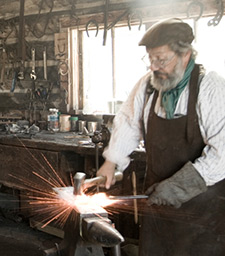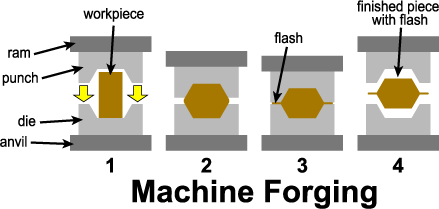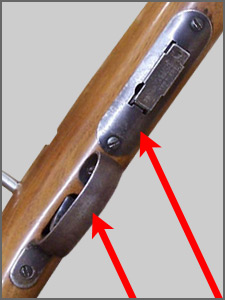Home | Glossary | Resources | Help | Contact Us | Course Map
Archival Notice
This is an archive page that is no longer being updated. It may contain outdated information and links may no longer function as originally intended.
Materials and Methods
Although other metal-casting processes are used in firearms manufacture, sand casting and investment casting are the most prevalent methods for ferrous alloys. Investment casting has all but replaced sand casting; older guns with sand-cast parts are still in circulation.
In the past two decades, there has been a considerable increase in the use of polymer plastics for major firearms components. In the past, plastic was used for nonstressed parts like butt plates, grips, and trigger guards. Handguns with high-strength polymer frames are commonplace.
Injection molding is the process for making precise plastic parts. Melted plastic under pressure is forced into a preheated mold. While the part is still in the mold, chilled water flushes through channels within the mold to set the surface of the plastic quickly. For dimension-critical parts, such as frames, the part is left in the mold for a time to allow uniform cooling without warping.
Forging
Forging is the hammering of a metal part into shape. It is among the oldest of the metalworking arts. The classic blacksmith pounding a hot metal part on his anvil is hand forging.
Early gun barrels were commonly formed by hand forging a thick piece of iron or steel around a rod of known diameter, called a mandrel. The smith worked the hot steel around the mandrel and fused the two edges together to form a tube. Once the metal cooled, the mandrel could be removed and a gun barrel with a relatively straight hole of constant diameter resulted. Although forming the basic tube with a mandrel was abandoned for muskets, rifles, and handguns long ago, it was used to manufacture thin-walled shotgun barrels until the twentieth century. The part being forged may be hot or cold; most forging operations used in the manufacture of major firearms components are performed on glowing hot metal. Glowing metal is easier to work with and less likely to break during shaping than cold metal. In addition to producing a required shape, metal molecules are compressed for greater strength. Cold forging may be performed on smaller parts and is often called swaging (SWAY-ging with a soft g as in George).
For labor savings and repeatability in mass production, machine forging is primarily used today. Machine forging yields a product with consistent gross size and shape from tooling attached to the surfaces that contact the metal. The tooling, called dies, carries the negative impression of the part to be produced, just as a casting mold is the negative of the final product. Typically, two dies are used to shape both sides of the part simultaneously.
In hammer forging, or drop forging, one die is on the stationary anvil block and the other on the ram or drop hammer. Machinery lifts the heavy ram, which may weigh several tons, vertically above the workstation. An operator or robotic unit places the glowing metal on the anvil and the entire ram freefalls onto it, delivering a tremendous blow. The hot metal yields to the force and assumes the shape of the dies. Both open and closed die forging can be performed. Closed die forging is used where any excess metal flow needs to be controlled.
Press forging uses similar tooling; the force is applied slowly instead of one or two sharp blows. Press forging, like closed die forging, allows excellent control of the material.
The benefits of machine forging include the following:
- Production of iron alloy parts with great strength and durability.
- Metal is heated but not melted, minimizing variations in grain structure.
- The ratios of the alloying materials are more easily maintained than in casting, where the metal becomes fully molten.
- Forging in well-designed dies allows the control of the grain structure in the metal.
- Control of natural flow lines that forging creates can be used to design areas in the part that require special stress-strain performance.
- Forging drives molecules closer together, improving durability.
Because of these benefits of forging, it is usually called on for the most demanding parts of a firearm, particularly the frame or receiver, the bolt mechanism, and the cylinder in revolvers. For years, the best gunmakers have touted their forged parts as an indication of quality. The advent of high-strength investment casting has placed another player in the race for top-performing materials. However, many gun owners consider forged parts to be a key indication of quality.
Stamping
In many ways, stamping is a subset of forging applied to thin, cold stock. An example outside the firearms industry is a metal car-body panel. Large sheets of flat metal are placed in a stamping press carrying dies that are the negative of the final part. In one blow, the cold sheet metal assumes the shape forced by the die design.
Typically, stamping is used to form thinner firearms parts that are not load-bearing, such as magazines and trigger guards. The U.S. caliber .30 M1 Garand rifle has a number of stamped parts, including those making up the trigger guard and magazine floorplate. For such military arms, where function takes precedence over form and beauty, stampings have been successfully used to produce the lower and upper receiver units for submachine guns and some battle rifles. The upper housing that carries the bolt in the UZI submachine gun is die-cut from a single sheet of metal, then folded into its final box shape in a stamping press. The corners are then welded to finish the unit.
Early variants of the famed (or to some people, infamous) Automat Kalashnikov (AK-47) had stamped receivers. The receiver consisted of a right- and left-hand stamped unit that were secured with machined spacer blocks and screwed or riveted together. Most AK-47s were produced with milled receivers.
Some SIG SAUER pistols have slides (the upper reciprocating unit in a semiautomatic handgun) that are stamped. The material is very heavy and many observers would fail to immediately identify the part as stamped. After stamping, the slide is formed into an inverted U, and a plate is precision welded to the front to support the barrel. A machined breechblock is pinned through at the rear. The result is a pistol of high quality and reliability.
A precision subset of stamping is fine blanking . Fine-blanking can produce smaller parts like triggers, hammers, or the shell latches for repeating shotguns to tolerances that rival machined parts. The limitation is material thickness. This means fine-blanking is usually seen in parts that are essentially flat and under 1/4 inch (6 mm) thick. However, several identical fine-blanked parts can be stacked to produce a thicker part. A common example is the latch in a .22 caliber Ruger Standard Auto pistol that secures the barrel extension to the frame. Three blanks are stacked to produce a relatively hefty latch.
Most firearm examiners will see stamped construction in military, law enforcement, and commercial firearms.
Additional Online Courses
- What Every First Responding Officer Should Know About DNA Evidence
- Collecting DNA Evidence at Property Crime Scenes
- DNA – A Prosecutor’s Practice Notebook
- Crime Scene and DNA Basics
- Laboratory Safety Programs
- DNA Amplification
- Population Genetics and Statistics
- Non-STR DNA Markers: SNPs, Y-STRs, LCN and mtDNA
- Firearms Examiner Training
- Forensic DNA Education for Law Enforcement Decisionmakers
- What Every Investigator and Evidence Technician Should Know About DNA Evidence
- Principles of Forensic DNA for Officers of the Court
- Law 101: Legal Guide for the Forensic Expert
- Laboratory Orientation and Testing of Body Fluids and Tissues
- DNA Extraction and Quantitation
- STR Data Analysis and Interpretation
- Communication Skills, Report Writing, and Courtroom Testimony
- Español for Law Enforcement
- Amplified DNA Product Separation for Forensic Analysts





